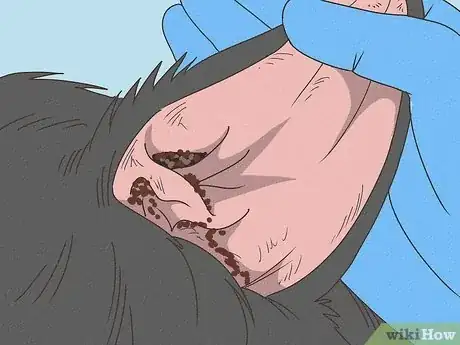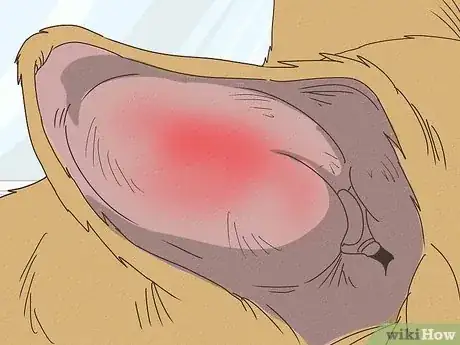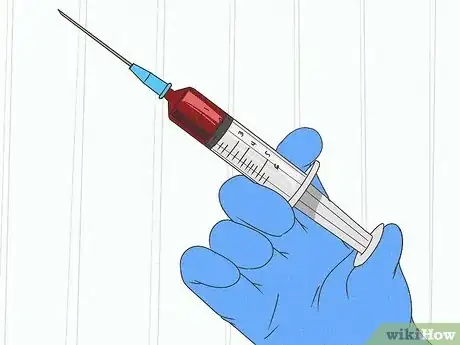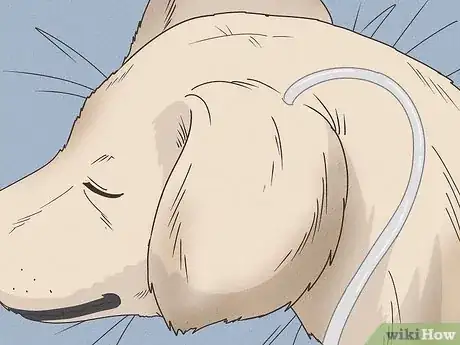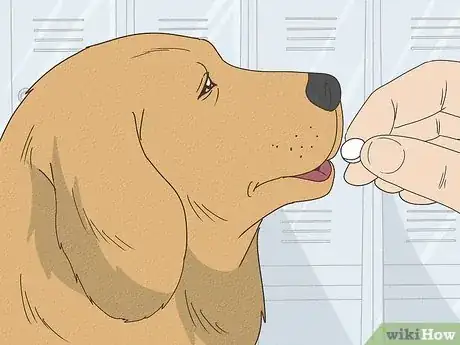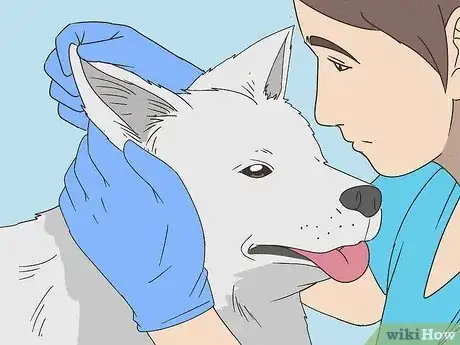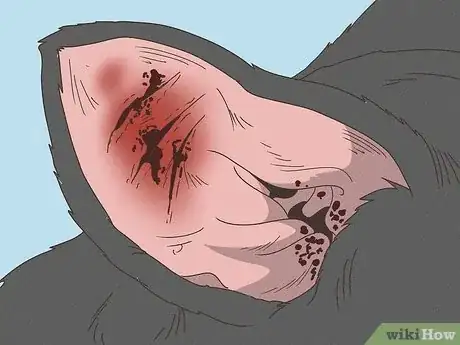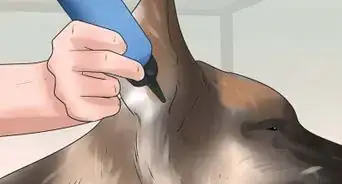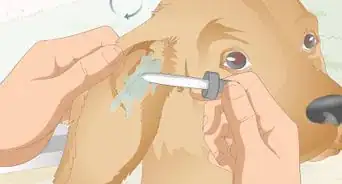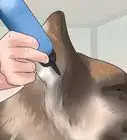This article was co-authored by Pippa Elliott, MRCVS and by wikiHow staff writer, Danielle Blinka, MA, MPA. Dr. Elliott, BVMS, MRCVS is a veterinarian with over 30 years of experience in veterinary surgery and companion animal practice. She graduated from the University of Glasgow in 1987 with a degree in veterinary medicine and surgery. She has worked at the same animal clinic in her hometown for over 20 years.
There are 15 references cited in this article, which can be found at the bottom of the page.
This article has been viewed 86,874 times.
Is your dog’s ear swollen? It might have an aural hematoma, which happens when blood accumulates under the skin on the outside of your dog’s ear. Aural hematomas aren’t dangerous, but they’re unsightly and can make your dog uncomfortable. We’re here to help you easily treat your dog’s aural hematoma at home. Additionally, we’ll explain when you need to go to the vet and what they can do to help your pup recover quickly.
Things You Should Know
- Aural hematomas will go away without treatment, but your dog will have cauliflower ear.
- When treating an aural hematoma at home, it’s best to have your dog wear an e-collar (also called a "cone of shame") so they can’t scratch their ear.
- Your vet can easily drain the hematoma using a needle or a short surgical procedure.
- Your vet will likely give your dog a steroid to help its ear heal faster.
Steps
Home Treatments
-
1Let your dog’s aural hematoma heal on its own. Your dog’s hematoma will heal without any treatment, though your dog might experience some discomfort. Just make sure to check your dog’s ear every day to make sure it’s getting better rather than worse.[1]
- With treatment, it usually takes 10 to 14 days for a hematoma to heal. If you let your dog’s ear heal naturally, it’ll likely take longer.[2]
-
2Put an e-collar around your dog’s neck to protect the ear. An e-collar, also called the "cone of shame," prevents your dog from scratching or rubbing its ear, which gives the ear time to heal. You can get an e-collar at your local pet store, online, or your vet. They come in different sizes, so pick one that’s labeled for your dog’s size. While your dog is wearing the e-collar, watch them closely because the cone can get stuck on stuff.[3]
- You may need to take off the e-collar so your dog can eat and drink water.
Advertisement -
3Expect some scarring on your pup’s healed ear. When a hematoma heals on its own, your dog will likely have a cauliflower ear, which is permanent. With cauliflower ear, the skin looks wrinkly and lumpy. It won’t cause any discomfort for your dog, but the skin will look damaged.[4]
- Getting veterinary treatment usually prevents cauliflower ear, especially if the hematoma is new.
When to See the Vet
-
1Take your dog to the vet if the hematoma is painful. In many cases, aural hematomas cause discomfort. If your dog is whining or tilting its head to one side, it’s probably best to take them to the vet. Your vet can make sure your pup is as comfortable as possible while its ear heals.[5]
- Your vet might prescribe painkillers for your dog. If so, follow the vet’s directions for giving your pup its pills.
-
2Go to the vet if your dog has an infection or parasite. Less often, ear infections, ear mites, and ticks can be the culprit behind an aural hematoma. If this is the case for your dog, you’ll need to take them to the vet to get a diagnosis and proper treatment.[6] If you don’t treat the underlying condition, your dog’s hematoma will keep coming back.[7]
- To see if your dog has ear mites, look for grainy discharge in its ear that looks like coffee grounds.[8]
- Look for the following symptoms of an ear infection: yellow or brown discharge, odor, scabs, redness, swelling, itching, head shaking, loss of balance, hearing loss, and walking in circles.[9]
-
3See the vet if the hematoma covers the entire ear. Small hematomas usually resolve on their own without treatment. However, a large amount of swelling usually requires vet treatment. Just to be safe, take your pup to the vet.[10]
- Similarly, if the hematoma is growing in size, it’s best to see your vet.
Vet Treatments
-
1Get a diagnosis and treatment for the underlying condition. To make a diagnosis, your vet will examine your dog’s ear. They may even insert an otoscope, which lets them look at the ear canal. Then, the doctor will probably swab the ear with a cotton swab or take a culture of any discharge that’s present.[11]
- Ear injury or infection: After giving your dog a sedative, your vet will clean out their ears and start them on an antibiotic, antifungal, or glucosteroid. You'll probably need to clean your dog’s ear daily for 5 to 7 days before you apply their ear medicine.[12]
- Ear mites: Your vet will likely clean out your dog’s ears. Then, they’ll prescribe a medication, like ivermectin, that kills parasites.[13]
- Food allergy: Your vet will put your dog on an elimination diet to find out which food your pup is allergic to. Then, you’ll stop feeding your dog that food.[14]
- Foreign objects: While your dog is sedated, your vet will flush the area with a sterile solution to wash out whatever is stuck in your dog’s ear. Then, they’ll give your dog antibiotics and a painkiller.[15]
-
2Ask your vet to drain the hematoma with a butterfly needle. This minimally-invasive procedure won’t hurt your dog, and it’ll help them get relief fast. After numbing the area, your vet will insert a needle into the hematoma. Then, they’ll drain out all of the trapped fluid. Afterward, your vet will wrap a bandage around the ear to protect it while it heals.[16]
-
3Let your vet add a drain if they recommend it. Your vet may recommend installing a drain in your dog’s ear to help clean out the hematoma. To make your dog comfortable, they’ll numb the area. Then, they’ll make a small incision and insert a silicone tube to drain all the fluid. Finally, your vet will wrap a compression bandage around your dog’s ear to help limit the swelling.[19]
- You’ll need to change your dog’s bandages every 2 to 3 days. In most cases, your vet will remove the bandage and tube after 5 to 7 days.[20]
-
4Consider surgery if your dog has persistent or recurring hematomas. Before doing surgery, your vet will sedate your dog under general anesthesia, or they’ll numb the area. Then, your vet will cut into the hematoma and massage out all of the fluid. Next, they’ll flush the area with a sterile solution to clean it before inserting sutures to close the wound.[21]
- With surgery, your dog will have minimal scarring from the hematoma, so it’s a great option if you want to prevent cosmetic damage to your pup’s ear.
-
5Give your dog any glucocorticoids prescribed by your vet. Typically, vets give dogs a steroid to help them heal after surgery for aural hematomas. In most cases, the medication will help your dog heal faster. Make sure you follow your vet’s directions so your pup get better as fast as possible.[22]
- Generally, your dog will be on an anti-inflammatory steroid for 10 days after the vet drains their hematoma.[23]
Symptoms & Causes
-
1Look for a red, fluid-filled swelling on your dog’s ear flap. Hematomas are essentially blood blisters, and they can range in size. They occur on the outer part of your dog’s ear, which is the furry side.[24] However, it’s easier to see the swelling on the inside of your dog’s ear, so check the inner ear flap for a bump or lump.[25]
- The entire ear might feel soft and mushy if the hematoma is large.
- Your dog may have swelling only on one ear, but sometimes they get hematomas on both sides.[26]
-
2Feel the swelling to see if it’s warm. When hematomas first develop, your dog’s skin will feel warm to the touch. Be gentle as you place your fingertips against the pup’s skin because the hematoma may cause discomfort.[27]
- As the hematoma heals, your dog’s skin will likely cool off.
-
3Watch to see if your dog scratches their ear or shakes their head. In most cases, dogs get a hematoma from rough scratching or head shaking. This trauma causes the blood vessels in their ear to break and fill the ear with blood.[28] Unfortunately, scratching and shaking can make their hematoma worse, so intervene when you notice your dog doing this.[29]
- If your dog keeps messing with their ear, putting an Elizabethan collar (e-collar) around their neck can stop them.
-
4Identify the cause of your dog’s hematoma so you can treat it. There’s no official cause for aural hematomas. In most cases, they happen after the skin on the ear is damaged.[30] However, it’s important to rule out other potential causes because the hematoma won’t go away completely unless you eliminate the underlying cause. Here are the typical causes of aural hematomas in dogs:[31]
- Injury to your dog’s ear, especially from scratching and shaking.
- Skin infections
- Parasites, like ear mites or ticks
- A foreign object, like glass, that’s trapped under your dog’s skin.
- Food allergies[32]
Expert Q&A
Did you know you can get expert answers for this article?
Unlock expert answers by supporting wikiHow
-
QuestionHow can I treat my dog's cauliflower ear at home?
 Pippa Elliott, MRCVSDr. Elliott, BVMS, MRCVS is a veterinarian with over 30 years of experience in veterinary surgery and companion animal practice. She graduated from the University of Glasgow in 1987 with a degree in veterinary medicine and surgery. She has worked at the same animal clinic in her hometown for over 20 years.
Pippa Elliott, MRCVSDr. Elliott, BVMS, MRCVS is a veterinarian with over 30 years of experience in veterinary surgery and companion animal practice. She graduated from the University of Glasgow in 1987 with a degree in veterinary medicine and surgery. She has worked at the same animal clinic in her hometown for over 20 years.
Veterinarian To get rid of the blood within the ear requires a vet to either drain the blood away or intervene with surgery. Sadly, there is no effective home remedy. Also, an ear infection can be the underlying reason the hematoma developed in the first case, so a vet needs to check if medical treatment is needed for this.
To get rid of the blood within the ear requires a vet to either drain the blood away or intervene with surgery. Sadly, there is no effective home remedy. Also, an ear infection can be the underlying reason the hematoma developed in the first case, so a vet needs to check if medical treatment is needed for this. -
QuestionWhat is surrendering a dog?
 Pippa Elliott, MRCVSDr. Elliott, BVMS, MRCVS is a veterinarian with over 30 years of experience in veterinary surgery and companion animal practice. She graduated from the University of Glasgow in 1987 with a degree in veterinary medicine and surgery. She has worked at the same animal clinic in her hometown for over 20 years.
Pippa Elliott, MRCVSDr. Elliott, BVMS, MRCVS is a veterinarian with over 30 years of experience in veterinary surgery and companion animal practice. She graduated from the University of Glasgow in 1987 with a degree in veterinary medicine and surgery. She has worked at the same animal clinic in her hometown for over 20 years.
Veterinarian
-
QuestionHow do you treat a hematoma on a dog's ear?
 Pippa Elliott, MRCVSDr. Elliott, BVMS, MRCVS is a veterinarian with over 30 years of experience in veterinary surgery and companion animal practice. She graduated from the University of Glasgow in 1987 with a degree in veterinary medicine and surgery. She has worked at the same animal clinic in her hometown for over 20 years.
Pippa Elliott, MRCVSDr. Elliott, BVMS, MRCVS is a veterinarian with over 30 years of experience in veterinary surgery and companion animal practice. She graduated from the University of Glasgow in 1987 with a degree in veterinary medicine and surgery. She has worked at the same animal clinic in her hometown for over 20 years.
Veterinarian The most successful outcome is with surgery under anesthesia. The vet makes an incision on the underside of the ear flap to drain the blood out, and then the flap is compressed using lots of sutures. Alternatively, small hematomas can respond to needle drainage with steroid injected into the resulting cavity. However, this procedure can need to be repeated, and doesn't always work.
The most successful outcome is with surgery under anesthesia. The vet makes an incision on the underside of the ear flap to drain the blood out, and then the flap is compressed using lots of sutures. Alternatively, small hematomas can respond to needle drainage with steroid injected into the resulting cavity. However, this procedure can need to be repeated, and doesn't always work.
References
- ↑ https://www.ncbi.nlm.nih.gov/pmc/articles/PMC7020633/
- ↑ https://www.ncbi.nlm.nih.gov/pmc/articles/PMC7020633/
- ↑ https://troyanimalhospital.com/2019/11/15/tipp-city-oh-vet-need-to-know-elizabethan-collar/
- ↑ https://www.ncbi.nlm.nih.gov/pmc/articles/PMC7020633/
- ↑ https://www.vet.cornell.edu/departments-centers-and-institutes/riney-canine-health-center/health-info/itchy-ear-problems
- ↑ https://www.pdsa.org.uk/pet-help-and-advice/pet-health-hub/conditions/aural-haematoma-in-dogs
- ↑ https://www.merckvetmanual.com/ear-disorders/diseases-of-the-pinna/auricular-hematomas-in-dogs,-cats,-and-pigs
- ↑ https://veterinarypartner.vin.com/default.aspx?pid=19239&id=4951535
- ↑ https://www.thomasvillevet.net/site/blog/2021/01/15/signs-ear-infection-dog
- ↑ https://www.veterinarypartner.com/Content.plx?P=A&C=11&A=566&S=0&EVetID=3001942
- ↑ https://www.vet.cornell.edu/departments-centers-and-institutes/cornell-feline-health-center/health-information/feline-health-topics/ear-mites-tiny-critters-can-pose-major-threat
- ↑ https://www.vet.cornell.edu/departments-centers-and-institutes/cornell-feline-health-center/health-information/feline-health-topics/ear-mites-tiny-critters-can-pose-major-threat
- ↑ https://www.vet.cornell.edu/departments-centers-and-institutes/cornell-feline-health-center/health-information/feline-health-topics/ear-mites-tiny-critters-can-pose-major-threat
- ↑ https://www.ncbi.nlm.nih.gov/pmc/articles/PMC6380261/
- ↑ https://www.northampton-vets.co.uk/pet-care/dogs/ear-conditions/38-common-causes-of-ear-problems-in-dogs
- ↑ https://www.acvs.org/small-animal/aural-hematoma
- ↑ https://onlinelibrary.wiley.com/doi/10.1111/jsap.12524
- ↑ https://www.ncbi.nlm.nih.gov/pmc/articles/PMC7020633/
- ↑ https://avmajournals.avma.org/view/journals/javma/260/S1/javma.20.12.0672.xml
- ↑ https://avmajournals.avma.org/view/journals/javma/260/S1/javma.20.12.0672.xml
- ↑ https://www.merckvetmanual.com/ear-disorders/diseases-of-the-pinna/auricular-hematomas-in-dogs,-cats,-and-pigs
- ↑ https://www.merckvetmanual.com/ear-disorders/diseases-of-the-pinna/auricular-hematomas-in-dogs,-cats,-and-pigs
- ↑ https://sciaeon.org/articles/Non-surgical-Treatment-of-Canine-Auricular-Hematoma-with-Intralesional-and-Systemic-Corticosteroids-A-Pilot-Study.pdf
- ↑ https://www.merckvetmanual.com/ear-disorders/diseases-of-the-pinna/auricular-hematomas-in-dogs,-cats,-and-pigs
- ↑ https://www.acvs.org/small-animal/aural-hematoma
- ↑ https://www.ncbi.nlm.nih.gov/pmc/articles/PMC7020633/
- ↑ https://www.ncbi.nlm.nih.gov/pmc/articles/PMC7020633/
- ↑ https://sciaeon.org/articles/Non-surgical-Treatment-of-Canine-Auricular-Hematoma-with-Intralesional-and-Systemic-Corticosteroids-A-Pilot-Study.pdf
- ↑ https://www.ncbi.nlm.nih.gov/pmc/articles/PMC7020633/
- ↑ https://avmajournals.avma.org/view/journals/javma/260/S1/javma.20.12.0672.xml
- ↑ https://www.acvs.org/small-animal/aural-hematoma
- ↑ https://www.merckvetmanual.com/ear-disorders/diseases-of-the-pinna/auricular-hematomas-in-dogs,-cats,-and-pigs
About This Article
If your dog has an aural hematoma, visit your vet to determine whether surgical draining is necessary, or whether the vet can drain the blood with a needle. Hematomas are often caused because the dog is shaking its head or scratching its ears excessively, so while you’re there, talk to your vet about possible causes for the hematoma, like an ear infection or ear mites. While your dog is recovering from the procedure, bandage the ear against your dog’s head, and place your dog in an e-collar if it continues to rub or scratch at the ear. Keep reading for information from our Veterinary co-author on the procedures your vet might use to treat the hematoma!




